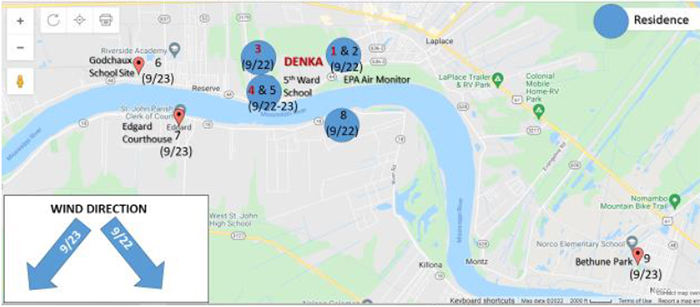Proof-of-Concept Demonstration Recommends Continuous Air Monitoring & Other Precautionary Practices in St. John Parish
April 11, 2022

“This was not a formal study to characterize exposures to chloroprene,” says Edward Trapido, ScD, FACE, Professor and Associate Dean for Research in the School of Public Health and Deputy Director for Population Science in the Stanley S. Scott Cancer Center at LSU Health New Orleans, who reviewed the report. “It was a proof-of-concept demonstration to evaluate an analytical protocol.”
Ten air samples were collected at offsite locations at different proximities from Denka conducted in September 2021. Urine samples were collected from seven residents at three of the residential locations. No production of chloroprene or neoprene was reported that month due to Hurricane Ida.Two of the ten air samples had detectable chloroprene at levels above EPA’s recommendation for maximum annual average chloroprene air concentration for lifetime exposures. These samples were taken near an elementary school. Some sites had detectable levels of other volatile organic compounds (VOCs), including toluene, benzene, xylene and 1,2,4-trimethylbenzene, but none exceeded EPA’s chemical-specific lifetime recommendations for non-cancer health effects.
“Chloroprene levels at or across the street from the elementary school were estimated to be 0.78 and 0.85 μg/m3 on September 23rd— approximately four times above the EPA’s recommended maximum annual average chloroprene air concentration of 0.2 μg/m3,” notes Adrienne Katner, DEnv, MS, Associate Professor of Environmental and Occupational Health Sciences at LSU Health New Orleans School of Public Health, who led the project. “This recommended chloroprene air concentration was set to limit cancer risk among 1 million persons to 100 cancer cases per year. Denka’s air monitors also detected chloroprene in September 2021, with concentrations as high as 4.7 μg/m3 (September 22nd) at the western edge of Denka’s property, and 24 μg/m3 (September 27th) at the eastern edge. These levels were between 23 and 2120 times above 0.2 μg/m3. The EPA’s chloroprene air limit is a recommendation not a required regulatory standard. However, it is important to understand that levels below state and national air quality standards cannot always ensure zero health risks, especially when considered in the context of simultaneous exposures to other facility-specific emissions.”Of nine urine samples from seven residents, all had detectable levels of DHBMA, a metabolite of chloroprene and 1,3-butadiene. HOBMA, CHPMA, Cl-MA metabolites were detected in urine samples, suggesting exposure to chloroprene, 1,3-butadiene and epichlorohydrin; however, the researchers were unable to verify the identity of these metabolites.
“Chloroprene continues to be detected offsite by EPA and Denka officials at levels of potential concern where vulnerable populations congregate or live,” Katner says. “Biomonitoring indicates resident exposure is occurring to likely known and/or probable carcinogens associated with plastics production. Gaps in scientific knowledge about the cancer and non-cancer health impacts of lifetime exposures to low levels of chloroprene and VOC mixtures on vulnerable populations like children, the elderly, immunocompromised, sick and pregnant women, support a need for precautionary practices by state and parish officials. There is a need for a cumulative risk assessment for all Denka emissions, especially considering the similarities in health outcomes from many of the VOCs. Health outcomes which are common for VOC’s include irritation to eyes, nose and throat, headaches and nausea, skin reactions, fatigue, damage to lungs, liver, kidneys, and central nervous systems, and blurred vision.”The report makes the following recommendations:
• Cumulative risk assessments should be conducted by LDH and LDEQ for health assessments and permit applications, respectively.• In addition to cancer outcomes, LDH should track non-cancer health outcomes to evaluate potential impacts to the population from multiple emissions released by Denka and other facilities in the area.
• LDH should implement a school-based health surveillance system.• If funds allow, biomonitoring should be used by LDH to quantify resident and child exposures to chloroprene.
• Denka should be required by LDEQ to conduct online real-time fence line and offsite continuous air monitoring to track the spatial dispersion and temporal patterns of chloroprene and other VOC air emissions.• It is critical that the LDH and the LDEQ work together to adopt proactive precautionary practices and policies and establish a trust-based supportive relationship with the community.
Donna Williams, DrPH, Professor and Director of the Louisiana Cancer Prevention and Control Program at LSU Health New Orleans School of Public Health says, “The call for public health intervention is the main message of this report. When risks to a population are plausible, mitigation and exposure prevention should be implemented.”______________________________________________________________________________________________________________ LSU Health Sciences Center New Orleans (LSU Health New Orleans) educates Louisiana's health care professionals. The state's health sciences university leader, LSU Health New Orleans includes a School of Medicine with branch campuses in Baton Rouge and Lafayette, the state's only School of Dentistry, Louisiana's only public School of Public Health, and Schools of Allied Health Professions, Nursing, and Graduate Studies. LSU Health New Orleans faculty take care of patients in public and private hospitals and clinics throughout the region. In the vanguard of biosciences research, the LSU Health New Orleans research enterprise generates jobs and enormous annual economic impact. LSU Health New Orleans faculty have made lifesaving discoveries and continue to work to prevent, advance treatment or cure disease. To learn more, visit http://www.lsuhsc.edu, http://www.twitter.com/LSUHealthNO, or http://www.facebook.com/LSUHSC.
